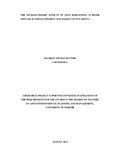| dc.description.abstract | Sand is a natural resource that exists at valley bottoms of rivers and one of its uses is
provision of raw material for construction. The building of homes, institutions and
towns require the use of sand at varying quantities. This result in sand harvesting at
increasing rates at the seasonal river bottoms which traverse the rural areas. Sand
harvesting is one of the serious environmental problems around the globe in the recent
years. Sand harvesting activities reduce land socio-economic value by causing land
degradation, loss of agricultural lands, low availability of water and of low quality
and loss of biodiversity as well as increased poverty among people in the area. To
address these problems NEMA has come up with sand harvesting guidelines which
need to be enforced.
The main objective of the study was to assess the socio-economic effects of sand
harvesting in Kathiani Division. The specific objectives were to determine how sand
harvesting activities have contributed to job creation in Kathiani Division; to find out
the extent to which sand harvesting activities have improved living conditions among
the people living in Kathiani Division; to determine whether sand harvesting activities
have affected education among the children; to determine how sand harvesting
activities have affected accessibility of better health services among people living in
Kathiani Division.
The research study adopted descriptive research design and targeted a population of
236 sand harvesting stakeholders in Kathiani Division. A sample size of 121
stakeholders was used for the study. Secondary data source were basically through
desk reviews of existing literature on sand harvesting and scholarly internet sources.
Primary data was gathered directly from the stakeholders using structured open-ended
questionnaire, observation and photographs. Quantitative data was analyzed using
descriptive statistics. Descriptive statistics such as frequency distribution and
percentages were used to describe data. The Statistical Package for Social Sciences
(SPSS) aided the analysis of the data collected. Inferential statistics, chi-square was
used to test the null hypotheses.
From the findings, the study found out that sand harvesting activities have
significantly contributed to job creation in Kathiani Division. The study further found
out sand harvesting activities have significantly improved living conditions among
people living in Kathiani Division; sand harvesting activities have significantly
affected education among people living in Kathiani Division. It finally found out that
sand harvesting activities have significantly affected accessibility of better health
services among the people living in Kathiani Division. The results indicate that sand
harvesting earnings are inadequate in the sense that the families cannot afford
textbooks and learning materials of their children. Families cannot access better
medical services from the income realized from sand harvesting activities. The study
recommended that NEMA Social Impact Assessment (SIA) need to be carried out to
optimize positive and mitigate negative effects of sand harvesting in Kathiani
Division. | en_US |

